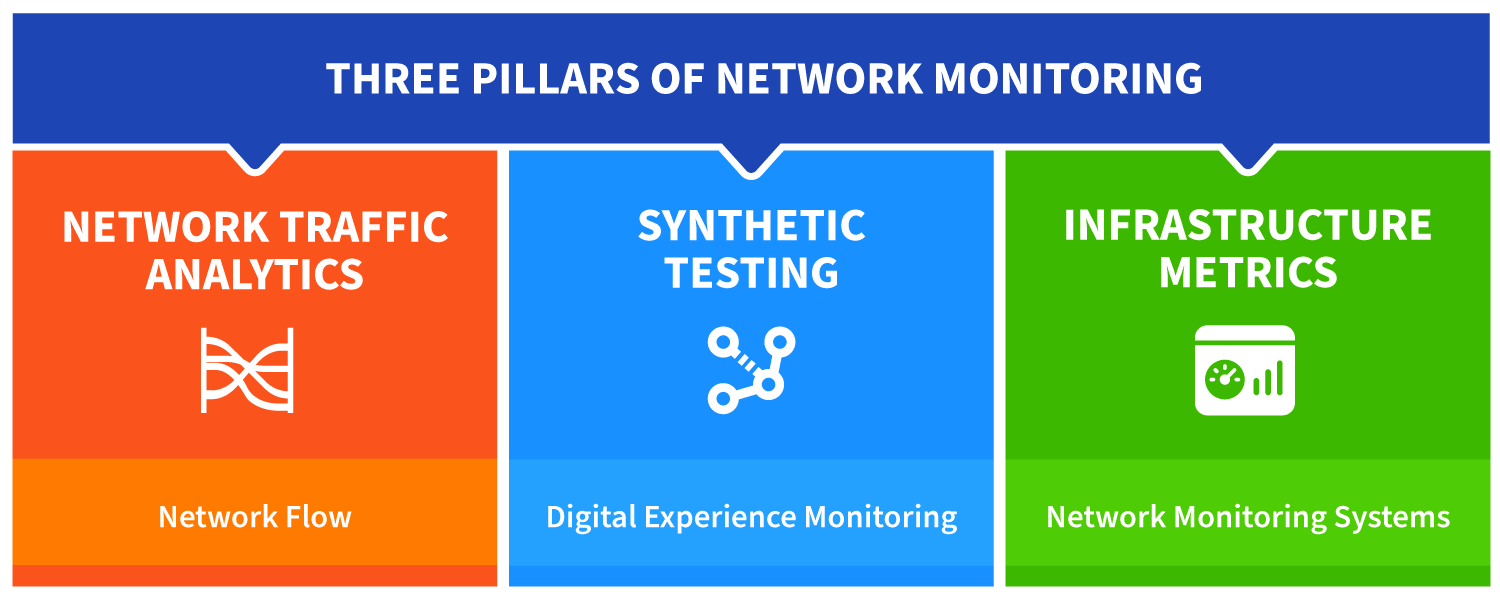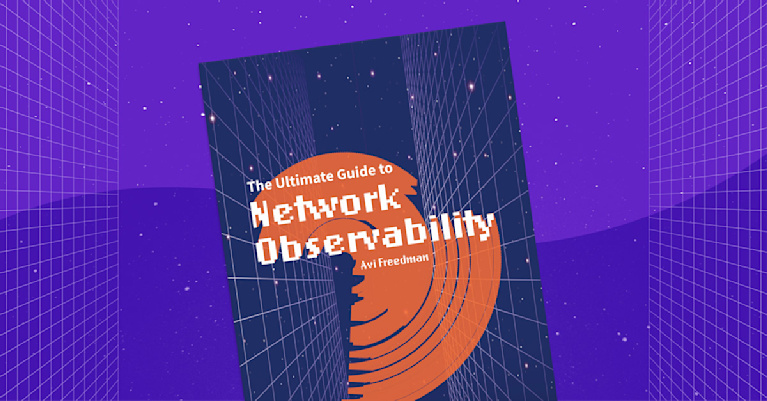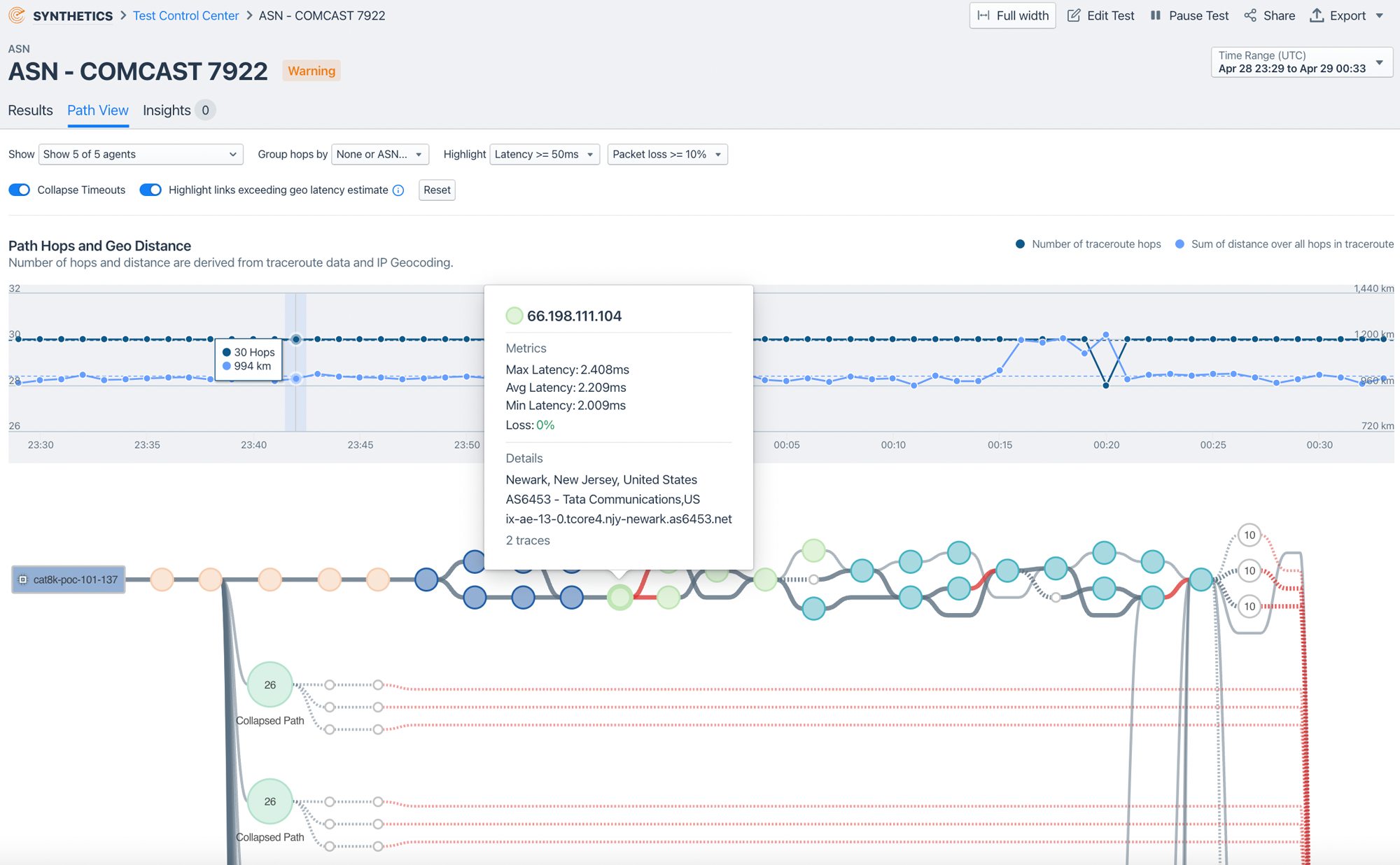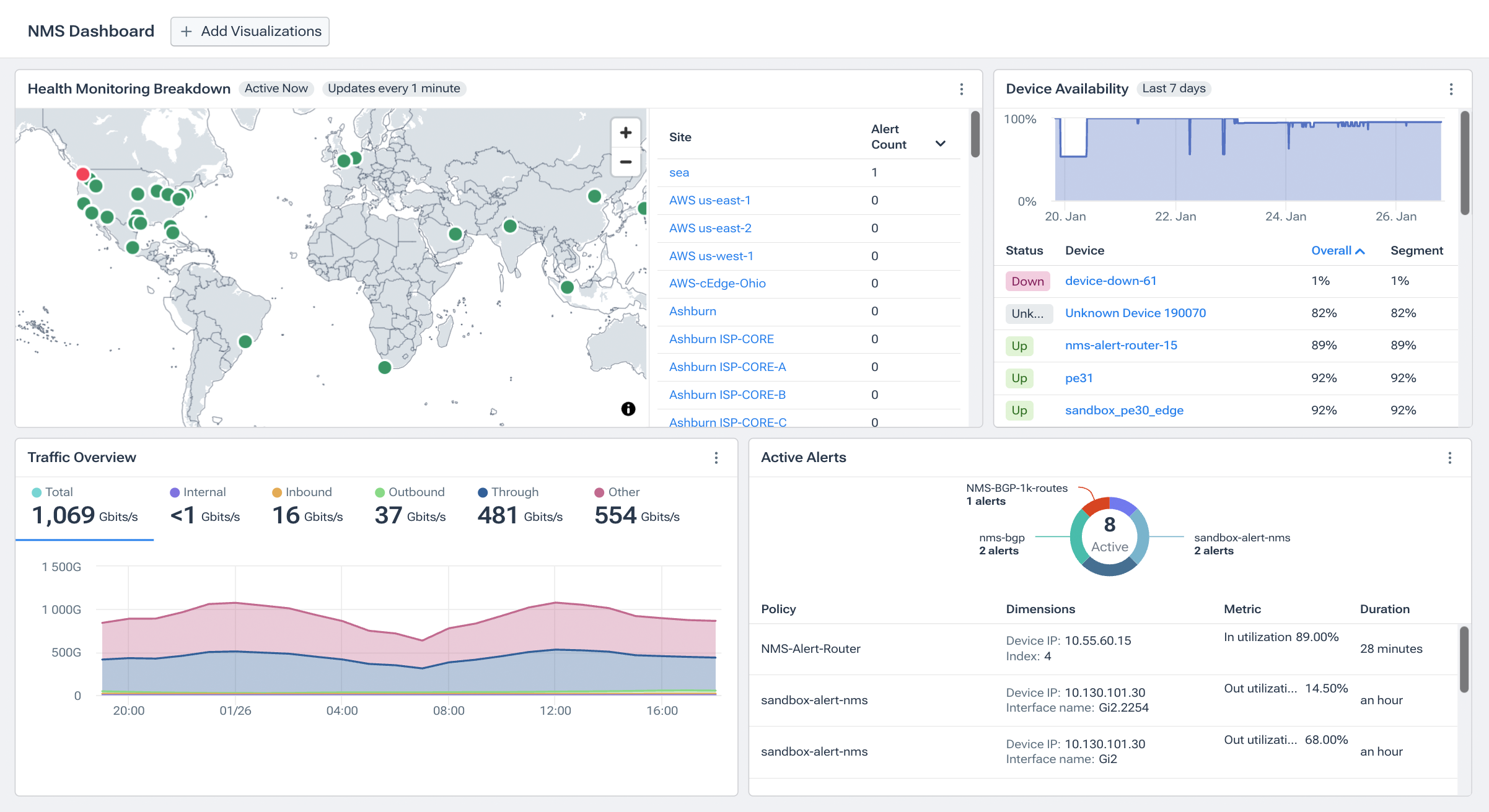Network Monitoring Architecture: Three Pillars of Modern Network Monitoring
This article discusses the central components of modern network monitoring architectures, focusing on the three key pillars: Traffic Analysis, Synthetic Testing, and Network Infrastructure Metrics. Each plays a crucial role in maintaining network integrity and agility.
What is Network Monitoring Architecture?
Network monitoring architecture is the structured framework used to oversee and manage a network’s performance, health, and security. At its core, this architecture encompasses various tools, protocols, and methodologies designed to continuously monitor and analyze a network’s operational state. These techniques include tracking traffic flow, identifying potential disruptions, and ensuring efficient data transmission across the network.
A robust network monitoring architecture typically consists of several key components:
-
Data Collection Tools: Data collection tools are central to network monitoring. These tools gather crucial information about traffic, device status, and overall system performance. Protocols like SNMP (Simple Network Management Protocol), NetFlow, and tools such as network flow analyzers are key in this process, providing real-time data for analysis and decision-making.
-
Analysis Software and Services: Once data is collected, analysis software and services are the next critical component. These systems interpret the vast amounts of collected data, sifting through to identify patterns, anomalies, and potential risks. This analysis is vital for understanding network behavior and preempting issues before they escalate.
-
Alerting Systems: Alerting systems form the reactive arm of network monitoring. They provide immediate notifications to network administrators about any irregularities or potential failures. This prompt alerting allows for quick interventions, minimizing downtime and maintaining network integrity.
-
Reporting Mechanisms: Finally, comprehensive reporting mechanisms synthesize the monitored data into actionable insights. These reports guide strategic decisions, helping maintain and upgrade the network in alignment with organizational needs.
In essence, network monitoring architecture is the backbone of network management, ensuring that all interconnected devices and services operate harmoniously and efficiently. It’s not just about preventing problems; it’s also about optimizing network performance to support an organization’s evolving needs.
These core components set the stage for network monitoring architecture’s deeper, more nuanced aspects, encapsulated in the “Three Pillars of Network Monitoring Architecture.”
What are the Three Pillars of Network Monitoring Architecture?
Network monitoring is a complex and evolving field encompassing three broad technology “pillars”: Traffic Analysis, Synthetic Testing, and Network Infrastructure Metrics. In a holistic approach to network monitoring (and the design of network performance monitoring architectures), each of these three monitoring techniques offers specific capabilities to ensure the monitored networks’ performance, security, and reliability. Modern network monitoring solutions like Kentik incorporate all of these components, offering an alternative to siloed, legacy tools.

Network Traffic Analysis (Flow Analysis)
The first pillar, Traffic Analysis, or Flow Analysis, involves passively monitoring network traffic. This approach offers granular insights into real-world network usage and is critical to understanding network dynamics.
-
Data Sources: Uses flow records, such as those from NetFlow protocols, VPC flow logs from cloud services, and packet traces through Deep Packet Inspection (DPI).
-
Event Analysis: Involves capturing and analyzing network events and changes through log records.
-
Pros of Network Traffic Analysis:
- Provides a detailed view of actual network usage.
- Offers insights into network performance and user behavior.
- Essential for detecting anomalies and potential security threats.
-
Cons of Network Traffic Analysis:
- Primarily limited to existing traffic flow.
- May not provide immediate, real-time data.
- Can be data-intensive, requiring effective data management strategies if deployed on-premises.
Synthetic Testing (Digital Experience Monitoring - DEM)
The second pillar, Synthetic Testing, a critical aspect of Digital Experience Monitoring (DEM), is a proactive approach that tests network functions to emulate actual user experiences. A primary goal of synthetic testing is to anticipate and mitigate performance issues before they impact real users.
- Testing and Data: Synthetic testing involves creating scenarios that mimic user actions to collect data on network responses and performance.
- User-Centric Focus: This technology aims to predict how the network will perform under various user conditions.
- Pros of Synthetic Testing:
- Identifies potential issues from an end-user perspective before they impact actual users.
- Allows for frequent, regular, and automated testing, enhancing preparedness.
- Assists in capacity planning and optimizing user experience.
- Cons of Synthetic Testing:
- Limited to the specific targets and scenarios set up for testing.
- May not capture all real-world conditions or spontaneous network events.
- Requires careful scenario design to ensure relevance and accuracy.
Network Infrastructure Metrics (Network Monitoring Systems - NMS)
The final pillar, Network Infrastructure Metrics, often managed through Network Monitoring Systems (NMS), is about maintaining and optimizing the physical and virtual components of the network infrastructure.
- Monitoring Tools: NMS tools uses protocols such as SNMP, Streaming Telemetry, and other advanced monitoring technologies to collect network device metrics such as up/down status, bandwidth usage, memory consumption, and CPU utilization.
- Event Handling: Includes mechanisms like SNMP Traps for real-time alerts on network conditions.
- Pros of Network Infrastructure Metrics:
- Provides direct insights into the health and status of network infrastructure.
- Essential for preventative maintenance and rapid issue resolution.
- Facilitates strategic planning for network upgrades and expansions.
- Cons of Network Infrastructure Metrics:
- May offer limited context regarding end-user experience or specific application performance.
- Requires integration of diverse monitoring tools for a comprehensive view in many cases.
In this short video, Kentik technology evangelist Leon Adato explains the basics of network monitoring and the three technology pillars of modern network montioring.
Robust Network Monitoring Architectures Integrate All Three Pillars
Integrating Traffic Analysis, Synthetic Testing, and Network Infrastructure Metrics transforms network monitoring from a reactive task into a proactive strategy. This comprehensive approach is vital for:
- Holistic Network Insight: Combining these pillars provides a complete picture of network health, from user experience to infrastructure performance.
- Proactive Problem Solving: The integrated approach allows for preemptive identification and resolution of network issues, enhancing overall network resilience.
- Enhanced User Experience: By ensuring the network is not only functioning—but also optimized—this approach directly contributes to a better end-user experience.
The sophistication and complexity of modern network monitoring, represented by these three pillars, ensure that networks are robust, reliable, agile, and adaptable.
Kentik’s Integration of Network Monitoring Pillars
Kentik’s solutions provide a comprehensive example of how modern network monitoring solutions can integrate the three crucial pillars of Traffic Analysis, Synthetic Testing, and Network Infrastructure Metrics. These integrations are essential in creating a robust network monitoring architecture.
Traffic Analysis with Kentik
Kentik has revolutionized network traffic analysis by leveraging advanced big data technologies and AI-driven insights. Kentik’s approach to network traffic analysis goes beyond traditional methods, offering a comprehensive and scalable solution that’s essential for effective network management, security, and optimization.

Kentik offers near real-time analysis of flow traffic data, providing live network intelligence crucial for capacity planning and resource optimization. By analyzing flow protocols like NetFlow, Kentik delivers sophisticated insights for strategic network planning, such as peering decisions, backbone upgrades, and routing policy planning. Additionally, Kentik’s AI and machine learning techniques automatically detect traffic, performance, and security anomalies across the entire network infrastructure.
Kentik enables a deep dive into traffic flow details, allowing network professionals to examine over 20 metrics and various categories like ASN, geo, port, IP, interface, VLAN, and MAC address. This level of detail is vital for accurately identifying and addressing network performance issues or security threats, such as DDoS attacks.
Kentik’s network traffic visualization tools offer a clear view of the entire network infrastructure, including both owned and external segments. Live network topology maps and detailed visualizations enable quick identification of network issues and their impact on applications. These features ensure that network operators always have a current and comprehensive picture of their network’s performance and security.
The definitive guide to running a healthy, secure, high-performance network

Enhanced Synthetic Testing with Kentik Synthetics
Kentik has significantly advanced the capabilities of Synthetic Testing with its comprehensive Kentik Synthetics solution. This sophisticated approach extends beyond monitoring actual network traffic to actively simulating user interactions and network traffic, providing a deeper insight into network performance and user experience.
Synthetic Testing and User Experience Monitoring
Kentik Synthetics actively simulates visitor or network traffic to a network-accessible resource. This process is crucial for testing availability, response times, and other performance metrics at all network stack layers, including network routing and application layers.
-
Testing Across Layers: Kentik Synthetics allows for tests at various network layers, including WEB/APP, DNS, Routing, and Network, covering aspects like browser page load, HTTP/API, and transaction testing.
-
Page Load and Transaction Monitoring: Kentik’s synthetic page load testing evaluates the load performance of each page element, providing response times for various page load stages and detailed insights through a waterfall graph. Synthetic Transaction Monitoring (STM) goes deeper, enabling benchmarking and troubleshooting of each element in an application, such as e-commerce sites, where each step from login to payment can be critical for user experience.
-
Comprehensive User Experience Monitoring: With capabilities like ingesting recorded Puppeteer scripts, capturing screenshots, and measuring total transaction times, Kentik offers an extensive set of tools to monitor and improve the performance of user actions on websites and applications.

Advanced Capabilities and Innovations
Kentik Synthetics integrates several important innovations and capabilities that enhance its effectiveness:
-
Contextualized Synthetic Test Results: Results are integrated with the context of actual traffic, offering a complete picture of the network’s performance and health.
-
Configurable Testing and Alerting: STM tests can be set up as both automatic and periodic, with customizable time intervals. Kentik’s platform allows for testing from a wide range of public and private agents, ensuring comprehensive coverage and flexibility.
-
Visualizing Test Results: Kentik’s platform presents STM results on a timeline with colored performance lags and graphs showing total completion times. This visualization aids in quickly identifying performance issues and their impact on user experience.
Enhanced Network Infrastructure Metrics with Kentik NMS
By combining traditional network monitoring capabilities with modern network observability, Kentik NMS (Network Monitoring System) offers a powerful solution tailored for today’s complex network landscapes. Kentik provides extensible metrics collection and visualization, preconfigured for traditional network monitoring tasks. This system is designed to handle the scale of the largest networks in the world, seamlessly integrating SNMP monitoring and streaming telemetry. It represents a unified approach to network monitoring, combining efficiency and flexibility to cater to the needs of both enterprises and service providers.

Kentik’s network troubleshooting and capacity planning tools also highlight the importance of network infrastructure metrics. Kentik helps NetOps teams resolve network problems quickly, using powerful visualizations and data to understand network events. Additionally, Kentik’s capacity planning workflow automates the task of ensuring that networks have sufficient resources, thus avoiding congestion surprises that can impact applications or users.
Advanced Features and AI for Comprehensive Monitoring
Kentik’s solutions include advanced features like DDoS defense and network cost analytics. The industry-leading DDoS detection and automated mitigation actions show how Kentik prioritizes network security within its monitoring architecture. Meanwhile, network cost analytics provide insights into bandwidth and resource costs, simplifying cost management and forecasting for network managers.
Kentik also delivers the most advanced artificial intelligence-based features for network monitoring: Kentik AI allows NetOps professionals and non-experts alike to ask questions—and immediately get answers—about the current status or historical performance of their networks using natural language queries. This tool allow administrators to understand on-premises, hybrid, and multicloud networking environments from a single query engine. Because it combines network data from all sorts of protocols—including flow data, SNMP, streaming telemetry, containers, and cloud flow logs—Kentik AI enables unprecedented visibility into modern networks.
Hybrid Cloud Visualization
Kentik’s hybrid cloud visualization also offers a unified view of network topology, state, traffic flows, network performance, and device health status. This feature underscores the importance of a holistic view in modern network monitoring, encompassing multi-cloud, on-prem, container, and internet infrastructures.

Kentik: Network Monitoring for Modern Network Architectures
Kentik’s comprehensive suite of network monitoring tools illustrates the future of network monitoring architecture. By integrating Traffic Analysis, Synthetic Testing, and Network Infrastructure Metrics, Kentik provides a powerful, unified solution for modern network challenges. This integration ensures that networks are robust, reliable, agile, and adaptable, ready to meet the ever-changing demands of the digital world.
Kentik offers a suite of advanced network monitoring solutions designed for today’s complex, multicloud network environments. The Kentik Network Observability Platform empowers network pros to monitor, run and troubleshoot all of their networks, from on-premises to the cloud. Kentik’s network monitoring solution addresses all three pillars of modern network monitoring, delivering visibility into network flow, powerful synthetic monitoring capabilities, and Kentik NMS, the next-generation network monitoring system.
To see how Kentik can bring the benefits of network observability to your organization, request a demo or sign up for a free trial today.


